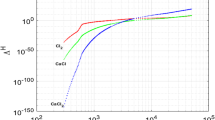Summary
The usual approach of classical statistical mechanics is employed to describe the partial equilibrium of a chemically reacting mixture of gases. It is assumed that each constituent, has a temperature peculiar to itself and deviates from the idela-gas state. A cluster expansion is obtained in a parametric form for the equation of state of the mixture as a whole. The case of a plasma is treated by the correlation function method to arrive at an expression of the free energy, which, in turn, is exploited to give a generalized ionization condition for a multitemperature plasma.
Riassunto
Nell’ambito della statistica classica si studia l’equilibrio termico parziale di una mistura di gas chimicamente reagenti. Ciascun costituente viene considerato come gas quasi-ideale con una propria temperatura. Si ottiene uno sviluppo in serie dell’equazione di stato analogo a quello per un gas ad una data temperatura (cluster expansion). Viene trattato poi il caso del plasma con l’uso delle funzioni di correlazione. Si ricava così una espressione dell’energia libera che consente di generalizzare la condizione di equilibrio di ionizzazione in un plasma a piú temperature.
Similar content being viewed by others
References
D. Kannappan andT. K. Bose:Phys. Fluids,20, 1668 (1977).
M. L. Mittal andG. Paran Gowda:J. Appl. Phys.,59, 1042 (1986).
H. Hamabata andT. Namikawa:J. Plasma Phys.,33 443 (1985).
G. Ben Dor andO. Igra:J. Plasma Phys.,27, 377 (1982).
L. Bighel, A. R. Collins andN. F. Cramer:J. Plasma Phys.,18, 77 (1977).
H. Grad:Theory of Rarefied Gas Dynamics, edited byF. Devienne (Pergamon Press, London, 1960).
H. R. Baum andT. M. Fang:Phys. Fludis,15, 1771 (1972).
T. F. Morse:Phys. Fluids,10, 1420 (1963).
N. T. Dunwoody andI. Muller:Arch. Ration. Mech. Anal.,29, 344 (1968).
A. Morro andM. Romeo:Nuovo Cimento D,7, 539 (1986).
K. Huang:Statistical Mechanics (J. Wiley & Sons, New York, N. Y., 1963).
L. Landau andE. Lifchitz:Physique statistique (Mir, Moscow, 1967).
A. Morro andM. Romeo:J. Non-Equilib. Thermodyn., to appear.
J. E. Mayer andM. G. Mayer:Statistical mechanics (J. Wiley & Sons, New York, N. Y., 1940).
Author information
Authors and Affiliations
Additional information
To speed up publication, the author of this paper has agreed to not receive the proofs for correction.
Rights and permissions
About this article
Cite this article
Romeo, M. Thermodynamics of mixtures and plasmas at partial equilibrium. Nuov Cim B 105, 243–257 (1990). https://doi.org/10.1007/BF02726100
Received:
Published:
Issue Date:
DOI: https://doi.org/10.1007/BF02726100




